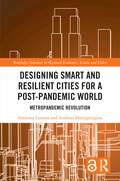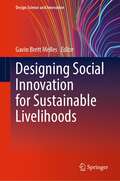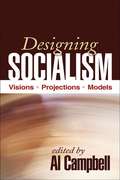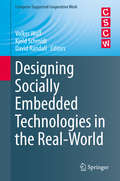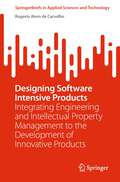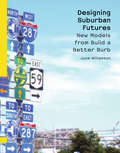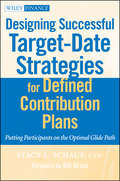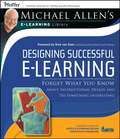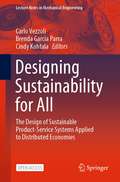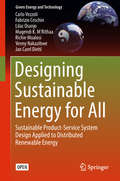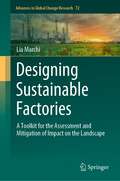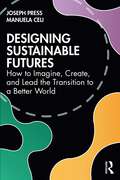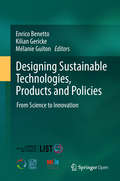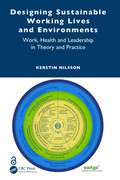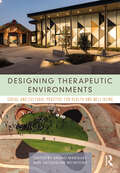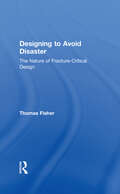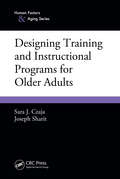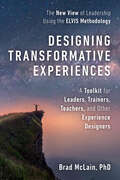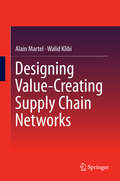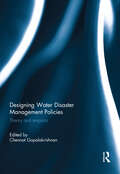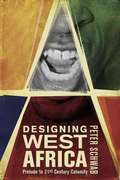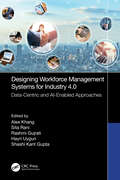- Table View
- List View
Designing Smart and Resilient Cities for a Post-Pandemic World: Metropandemic Revolution (Routledge Advances in Regional Economics, Science and Policy)
by Anthony Larsson Andreas HatzigeorgiouAre pandemics the end of cities? Or do they present an opportunity for us to reshape cities in ways making us even more innovative, successful, and sustainable? Pandemics such as COVID-19 (and comparable disruptions) have caused intense debates over the future of cities. Through a series of investigative studies, Designing Smart and Resilient Cities for a Post-Pandemic World: Metropandemic Revolution seeks to critically discuss and compare different cases, innovations and approaches as to how cities can utilise nascent and future digital technology and/or new strategies in order to build stronger resilience to better tackle comparable large-scale pandemics and/or disruptions in the future. The authors identify ten separate societal areas where future digital technology can impact resilience. These are discussed in individual chapters. Each chapter concludes with a set of proposed "action points" based on the conclusions of each respective study. These serve as solid policy recommendations of what courses of action to take to help increase the resilience in smart cities for each designated area. Securing resilience and cohesion between each area will bring about the metropandemic revolution. The book features a foreword by Nobel laureate Peter C. Doherty and an afterword by Professor of Urban Technologies, Carlo Ratti. It provides fresh and unique insights on smart cities and futures studies in a pandemic context, offers profound reflections on contemporary societal functions and the needs to build resilience and combines lessons learned from historical pandemics with possibilities offered by future technology.
Designing Social Innovation for Sustainable Livelihoods (Design Science and Innovation)
by Gavin Brett MellesThis volume discusses how design broadly understood as design of business, policy, product, system, etc. can produce socially responsible innovations with livelihoods consequences. Sustainable Livelihoods Framework (SLF) is a robust framework for analysing and measuring social impact for excluded populations and groups. This is illustrated with case studies from India, Sri Lanka, Bangladesh, Nepal by discussing how initiatives concerned with design in the broad sense have the potential to create sustainable livelihoods. This volume will be of interest to scholars and practitioners in Sustainable Development and Design.
Designing Socialism
by Al CampbellThis highly readable volume explores what contemporary models of socialism have to offer for envisioning a better world and developing feasible alternatives to neoliberalism and pervasive inequality. The book is organized around clearly stated questions that capture core issues and debates. Concise contributions from leading thinkers address the theoretical and historical justification for socialism, what a socialist society would look like, how self-interest and the interests of society can be reconciled, the stages and productive forces of socialism, and how socialist growth differs from capitalist growth. Two related book reviews are included. This volume was originally published as a special issue of Science & Society (Vol. 76, No. 2, 2012), editor, David Laibman, PhD.
Designing Socially Embedded Technologies in the Real-World
by David Randall Volker Wulf Kjeld SchmidtThis book is concerned with the associated issues between the differing paradigms of academic and organizational computing infrastructures. Driven by the increasing impact Information Communication Technology (ICT) has on our working and social lives, researchers within the Computer Supported Cooperative Work (CSCW) field try and find ways to situate new hardware and software in rapidly changing socio-digital ecologies. Adopting a design-orientated research perspective, researchers from the European Society for Socially Embedded Technologies (EUSSET) elaborate on the challenges and opportunities we face through the increasing permeation of society by ICT from commercial, academic, design and organizational perspectives. Designing Socially Embedded Technologies in the Real-World is directed at researchers, industry practitioners and will be of great interest to any other societal actors who are involved with the design of IT systems.
Designing Software Intensive Products: Integrating Engineering and Intellectual Property Management to the Development of Innovative Products (SpringerBriefs in Applied Sciences and Technology)
by Rogerio Atem de CarvalhoThis book guides the reader through a design process that was tested and optimized in companies and design bureaus. It not only smoothly integrates modern product development techniques, but also addresses, for each phase, issues related to the management of intangible assets. There are several books on the product design process, as well as on the development of innovative products in general. However, none of them addresses how to integrate the engineering techniques with the necessary aspects of Intellectual Property Management. With a focus on software intensive products in general, the book presents a meta-process that adapts to product design in any area where the software element is an important factor in product functionality and innovation.
Designing Specific Growth Initiatives: A Discovery-Driven Approach
by Ian C. Macmillan Rita Gunther McgrathOnce corporate leadership has defined what success should look like for the whole portfolio of new initiatives it will be pursuing, the next step is to flesh out discovery-driven plans for each of the major initiatives. This chapter shows you how to connect your growth strategy and internal processes to your specific strategic initiatives and provides an example of how to start a discovery-driven plan. This chapter is excerpted from "Discovery-Driven Growth: A Breakthrough Process to Reduce Risk and Seize Opportunity."
Designing Suburban Futures
by June WilliamsonSuburbs deserve a better, more resilient future. June Williamson shows that suburbs aren't destined to remain filled with strip malls and excess parking lots; they can be reinvigorated through inventive design. Drawing on award-winning design ideas for revitalizing Long Island, she offers valuable models not only for U. S. suburbs, but also those emerging elsewhere with global urbanization. Williamson argues that suburbia has historically been a site of great experimentation and is currently primed for exciting changes. Today, dead malls, aging office parks, and blighted apartment complexes are being retrofitted into walkable, sustainable communities. Williamson shows how to expand this trend, highlighting promising design strategies and tactics. She provides a broad vision of suburban reform based on the best schemes submitted in Long Island's highly successful "Build a Better Burb" competition. Many of the design ideas and plans operate at a regional scale, tackling systems such as transit, aquifer protection, and power generation. While some seek to fundamentally transform development patterns, others work with existing infrastructure to create mixed-use, shared networks. Designing Suburban Futures offers concrete but visionary strategies to take the sprawl out of suburbia, creating a vibrant, new suburban form. It will be especially useful for urban designers, architects, landscape architects, land use planners, local policymakers and NGOs, citizen activists, students of urban design, planning, architecture, and landscape architecture.
Designing Successful Target-Date Strategies for Defined Contribution Plans: Putting Participants on the Optimal Glide Path (Wiley Finance #594)
by Stacy L. SchausThe ultimate guidebook for navigating the new world of pensions and retirement plans In the wake of the explosive growth of defined contribution (DC) plans invested with target date strategies, and the understanding of how important these strategies can be in effectively meeting retirement income goals, plan sponsors are seeking more optimal target date approaches. This timely book provides you with in-depth answers from the nation's most qualified and experienced experts to pressing questions about DC plan design. Presents the views of individuals from all across the market Includes a broad range of plan sponsors both in the corporate world and in the public/government sectors Offers views from consultants and advisors from the most respected firms, academics who teach at leading universities, and other innovative leaders With a broad range of knowledge and insight, Designing Successful Target Date Strategies in Defined Contribution Plans helps you understand the evolution of DC plans, pulls together all angles of what it takes to develop custom target date strategies, and provides you with a look ahead to the future.
Designing Successful e-Learning
by Michael W. AllenThis is the second volume of six in Michael Allen's e-Learning Library--a comprehensive collection of proven techniques for creating e-learning applications that achieve targeted behavioral outcomes through meaningful, memorable, and motivational learning experiences. This book examines common instructional design practices with a critical eye and recommends substituting success rather than tradition as a guide. Drawing from theory, research, and experience in learning and behavioral change, the author provides a framework for addressing a broader range of learner needs and achieving superior performance outcomes.
Designing Sustainability for All: The Design of Sustainable Product-Service Systems Applied to Distributed Economies (Lecture Notes in Mechanical Engineering)
by Carlo Vezzoli Cindy Kohtala Brenda Garcia ParraThis open access book introduces design for Sustainable Product-Service Systems (S.PSS) and for Sustainable Distributed Economies (S.DE). These are introduced as technical and operative tools for the development of a new generation of designers, responsible and capable of designing environmentally, socially and economically sustainable solutions, accessible to all. The book provides a comprehensive framework and also practical tools to support the system design for sustainability process. It overviews methodologies, tools and strategies for Sustainable PSS design applied to Distributed Economies (DE) and provides strategies and design guidelines. All of these are highlighted and expanded upon with international case studies.
Designing Sustainable Energy for All: Sustainable Product-service System Design Applied To Distributed Renewable Energy (Green Energy and Technology)
by Jan Carel Diehl Fabrizio Ceschin Carlo Vezzoli Lilac Osanjo Mugendi K. M’Rithaa Richie Moalosi Venny NakazibweThis open access book addresses the issue of diffusing sustainable energy access inlow- and middle-income contexts.Access to energy is one of the greatest challenges for many people living in low-income and developing contexts, as around 1.4 billion people lack access to electricity.Distributed Renewable Energy systems (DRE) are considered a promising approachto address this challenge and provide energy access to all. However, even if promising,the implementation of DRE systems is not always straightforward.The book analyses, discusses and classifies the promising Sustainable Product-ServiceSystem (S.PSS) business models to deliver Distributed Renewable Energy systems in aneffective, efficient and sustainable way. Its message is supported with cases studies andexamples, discussing the economic, environmental and socioethical benefits as wellas its limitations and barriers to its implementation. An innovative design approach isproposed and a set of design tools are supplied, enabling readers to create and developSustainable Product-Service System (S.PSS) solutions to deliver Distributed RenewableEnergy systems.Practical applications of the book’s design approach and tools by companies andpractitioners are discussed and the book will be of interest to readers in design, industry,governmental institutions, NGOs as well as researchers.
Designing Sustainable Factories: A Toolkit for the Assessment and Mitigation of Impact on the Landscape (Advances in Global Change Research #72)
by Lia MarchiEconomic constraints and lack of knowledge often prevent companies - especially small and medium enterprises - from harmonizing their facilities with the landscape. As a result, factories significantly impact the quality of our living environment, in terms of physical effects on the ecosystem, perceptual interferences with the surroundings, and disturbances on local communities. At both the design and maintenance stages, a set of appropriate tools can assist businesses in becoming more aware of their impacts and identifying possible mitigation strategies. The book presents an assessment tool and a library of inspiring design tactics for factories, with examples of the benefits and synergies for the environment, the scenery, the community, and the company itself. The purpose is to elicit more than a simple reflection about what a sustainable factory entails. It is rather to encourage and assist both businesses and designers in mitigating the impact of industrial facilities on the landscape as holistically as possible.
Designing Sustainable Futures: How to Imagine, Create, and Lead the Transition to a Better World
by Manuela Celi Joseph PressWe are in a decisive decade that demands more inspired and informed practitioners who can use positive futures to rebalance the present. The book you hold seeks to be a thought‑provoking approach to imagine, create, and lead the journey to a more sustainable world – where a spectrum of choices, including regenerative practices, await conscientious citizens, companies, and communities.With this objective, and to help reverse the megatrends of economic disparity, social injustice, and climate change, the Institute for the Future (IFTF) and the Design Department of the Politecnico di Milano came together to prototype an approach to prepare all practitioners who seek to leverage the future to infuse our present with more impact and agency.Guided by global experts and inspired by a growing network of future‑makers, the authors share essential insights from this emerging landscape, offering thought‑provoking theory, innovative experiments, real‑world experiences, and practitioner stories. We draw insight and inspiration from many contemporary theories and practices, including strategic foresight, experiential futures, speculative design, design fiction, systems design, participatory design, and transformative leadership, and an emerging entry with genAI‑augmented design.Regardless of whether you have a design or management background, or want to create a for‑profit or non‑profit, this book enables professionals across industries, as well as students preparing for a career in strategy, innovation, or transformation, the knowledge, skills, and confidence to strengthen resilience and guide the transition to the more sustainable practices of a better world.
Designing Sustainable Technologies, Products and Policies: From Science To Innovation
by Enrico Benetto Kilian Gericke Mélanie GuitonThis open access book provides insight into the implementation of Life Cycle approaches along the entire business value chain, supporting environmental, social and economic sustainability related to the development of industrial technologies, products, services and policies; and the development and management of smart agricultural systems, smart mobility systems, urban infrastructures and energy for the built environment. The book is based on papers presented at the 8th International Life Cycle Management Conference that took place from September 3-6, 2017 in Luxembourg, and which was organized by the Luxembourg Institute of Science and Technology (LIST) and the University of Luxembourg in the framework of the LCM Conference Series.
Designing Sustainable Working Lives and Environments: Work, Health and Leadership in Theory and Practice
by Kerstin NilssonWork is central to people’s lives and the course of their life. The opportunities and chances an individual can have in their life are significantly connected to work. Individuals' work is also crucial for organisations, companies and for the whole of society. There is a constant need to make changes and readjustments of working life since these can deeply affect the individual and their employability. To make working lives more healthy, sustainable and attractive, being aware of the measures and changes that can be achieved in practice is of crucial importance. This book bridges the gap between the theories and explanatory models offered in research and actual work environments and workplaces.This book constitutes a theoretical framework that visualises the complexity of working life and increases the knowledge and awareness of individuals, companies, organisations and society regarding different factors and patterns. It aims to support individual reflections and joint discussions into daily operations on the individual, organisational and societal level. This book contains practical tools to use in daily working life that analyse possible risks in the work environment when planning measures and actions for health promotion. These practical tools are derived from the four spheres for action and employability in the SwAge model. Developed by the author, the SwAge model (Sustainable Working Life for All Ages) is a theoretical, explanatory model that explains the complexity of creating a healthy and sustainable working life for all ages. By using the SwAge model as a comprehensible framework, the reader will be able to visualise the complexity of factors that affect and influence whether people are able to and want to participate in working life and in the work environment, thereby contributing to increased employability.Designing Sustainable Working Lives and Environments is an essential read for students, researchers, work environment engineers, ergonomics and human factor specialists, occupational health and safety practitioners, business managers, HR staff, leadership decision-makers and labour union professionals.The Open Access version of this book, available at http://www.taylorfrancis.com, has been made available under a Creative Commons Creative Commons Attribution (CC-BY) 4.0 license
Designing Therapeutic Environments: Social and Cultural Practice for Health and Well-Being
by Bruno Marques Jacqueline McIntoshThis book draws on the relationship between culture and the environment and its connection with health and well-being. Therapeutic environments are settings that comprise the physical, ecological, psychological, spiritual and social environments associated with treatment and healing. Throughout the chapters, the understanding of therapeutic environments is broadened through the exploration of specific Indigenous cultural and social dimensions. Case studies comprise a combination of research papers regarding the theoretical and conceptual underpinnings of therapeutic environments and their application following traditional methods. This book contributes to the expanding body of knowledge focusing on the role of therapeutic environments and their role in shaping health and well-being through the development of new research methods.This book is essential for practitioners, scholars and students in architecture, landscape architecture, interior architecture, urban design, planning, geography, building science, public health and environmental engineering.
Designing To Avoid Disaster: The Nature of Fracture-Critical Design
by Thomas FisherRecent catastrophic events, such as the I-35W bridge collapse, New Orleans flooding, the BP oil spill, Port au Prince's destruction by earthquake, Fukushima nuclear plant's devastation by tsunami, the Wall Street investment bank failures, and the housing foreclosure epidemic and the collapse of housing prices, all stem from what author Thomas Fisher calls fracture-critical design. This is design in which structures and systems have so little redundancy and so much interconnectedness and misguided efficiency that they fail completely if any one part does not perform as intended. If we, as architects, planners, engineers, and citizens are to predict and prepare for the next disaster, we need to recognize this error in our thinking and to understand how design thinking provides us with a way to anticipate unintended failures and increase the resiliency of the world in which we live. In Designing to Avoid Disaster, the author discusses the context and cultural assumptions that have led to a number of disasters worldwide, describing the nature of fracture-critical design and why it has become so prevalent. He traces the impact of fracture-critical thinking on everything from our economy and politics to our educational and infrastructure systems to the communities, buildings, and products we inhabit and use everyday. And he shows how the natural environment and human population itself have both begun to move on a path toward a fracture-critical collapse that we need to do everything possible to avoid. We designed our way to such disasters and we can design our way out of them, with a number of possible solutions that Fisher provides.
Designing Training Programs
by Zeace Nadler Leonard NadlerFirst published in 1994. Routledge is an imprint of Taylor & Francis, an informa company.
Designing Training and Instructional Programs for Older Adults (Human Factors and Aging Series)
by Sara J. Czaja Joseph SharitCurrent and emerging trends in the domains of health management and the work sector, the abundance of new consumer products pervading the marketplace, and the desires of many older adults to undertake new learning experiences means that older adults, like their younger counterparts, will need to continually engage in new learning and training. Thus
Designing Transformational Customer Experiences
by Stefan ThomkeAnyone who has recently travelled, gone shopping, or tried to have a problem solved may have little recollection of the experience. Worse yet, some are frustrated by the lack of responsiveness or empathy that they encountered. The reality is that most customer experiences are mediocre, forgettable, and some are plain awful. But once in a blue moon, an experience is so great that it leaves positive memories for years. Why do some product or service experiences have that undeniable "wow" factor, while others lack that pizzazz, relegating them to either being loathed or erased from memory? This case prepares participants for an in-class exercise in which they discover design principles that make experiences great. The exercise uses two methodologies: LEGO® Serious Play® (LSP) and Storytelling. It requires the purchase of special purpose LEGO® elements. Teaching Note for HBS No. 617-051.
Designing Transformative Experiences: A Toolkit for Leaders, Trainers, Teachers, and other Experience Designers
by Brad McLainOffering a new lens on leadership and living, this research-based guide shows how to design experiences that can touch hearts, provoke minds, and change lives in powerful ways.Transformative experiences are life events that change our sense of self in important ways. How do they work? What elements do they require? How can we learn to design them intentionally?By embracing the research-based approach of ELVIS (the Experiential Learning Variables and Indicators System), this book details how to recast yourself as an Experience Design Leader, one that can provide those in your organization with the opportunities needed to reflect and grow as individuals.Beginning with the ELVIS Framework, you will gain deep foundational insight into how transformative experiences work. And then with the ELVIS Toolkit, which includes seven practical design elements, you will have the key to unlocking these powerful experiences for yourself and others.Whether you are new to the idea of designing experiences for others or are a seasoned veteran, ELVIS shows you how to tap into the psychology operating behind the most powerful and important experiences of our lives-those that shape who we are.
Designing Value-Creating Supply Chain Networks
by Alain Martel Walid KlibiFocusing on the design of robust value-creating supply chain networks (SCN) and key strategic issues related to the number; location, capacity and mission of supply chain facilities (plants, distribution centers) - as well as the network structure required to provide flexibility and resilience in an uncertain world - this book presents an innovative methodology for SCN reengineering that can be used to significantly improve the bottom line of supply chain dependent businesses. Providing readers with the tools needed to analyze and model value creation activities, Designing Value-Creating Supply Chain Networks examines the risks faced by modern supply chains, and shows how to develop plausible future scenarios to evaluate potential SCN designs. The design methods proposed are based on a visual representation formalism that facilitates the analysis and modeling of SCN design problems, book chapters incorporate several example problems and exercises which can be solved with Excel tools (Analysis tools and Solver) or with commercial statistical and optimization software.
Designing Water Disaster Management Policies: Theory and Empirics
by Chennat GopalakrishnanThis book represents a landmark effort to probe and analyze the theory and empirics of designing water disaster management policies. It consists of seven chapters that examine, in-depth and comprehensively, issues that are central to crafting effective policies for water disaster management. The author uses historical surveys, institutional analysis, econometric investigations, empirical case studies, and conceptual-theoretical discussions to clarify and illuminate the complex policy process.The specific topics studied in this book include a review and analysis of key policy areas and research priority areas associated with water disaster management, community participation in disaster risk reduction, the economics and politics of ‘Green’ flood control, probabilistic flood forecasting for flood risk management, polycentric governance and flood risk management, drought management with the aid of dynamic inter-generational preferences, and how social resilience can inform SA/SIA for adaptive planning for climate change in vulnerable areas.A unique feature of this book is its analysis of the causes and consequences of water disasters and efforts to address them successfully through policy-rich, cross-disciplinary and transnational papers. This book is designed to help enrich the sparse discourse on water disaster management policies and galvanize water professionals to craft creative solutions to tackle water disasters efficiently, equitably, and sustainably. This book should also be of considerable use to disaster management professionals, in general, and natural resource policy analysts.This book was published as a special issue of the Journal of Natural Resource Policy Research.
Designing West Africa: Prelude To 21st Century Calamity
by Peter SchwabMany African nations are now described as 'fourth world nations', ones which essentially have no future. How could this have happened? Through the scope of the 1960's, the first decade of African independence, Peter Schwab presents a compelling and provocative answer to this question. Designing West Africa tells the story of a pivotal decade in African history, when the fate of the continent was decided. Focusing on the six most visible leaders of the period - painting detailed portraits of them both as leaders and as people - Schwab looks at how Africa served as a ground to play out larger international conflicts, namely the Cold War. He does not fall back on blaming non-African involvement for the failure to build a visible leadership for the continent; rather he critiques the African leaders themselves for their individual failings.
Designing Workforce Management Systems for Industry 4.0: Data-Centric and AI-Enabled Approaches
by Alex Khang Sita Rani Rashmi Gujrati Hayri Uygun Shashi Kant GuptaThis book brings insight to the HR management system and offers data-centric approaches and AI-enabled applications for the design and implementation strategies used for workforce development and management. Designing Workforce Management Systems for Industry 4.0: Data-Centric and AI-Enabled Approaches focuses on the mechanisms of proposing solutions along with architectural concepts, design principles, smart solutions, and intelligent predictions with visualization simulation. Data visualization for the metrics of management systems and robotic process automation applications and tools are also offered. This book is also useful as a reference for those involved in AI-enabled applications, data analytics, data visualization, as well as systems engineering and systems designing.
